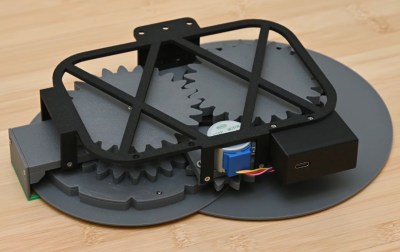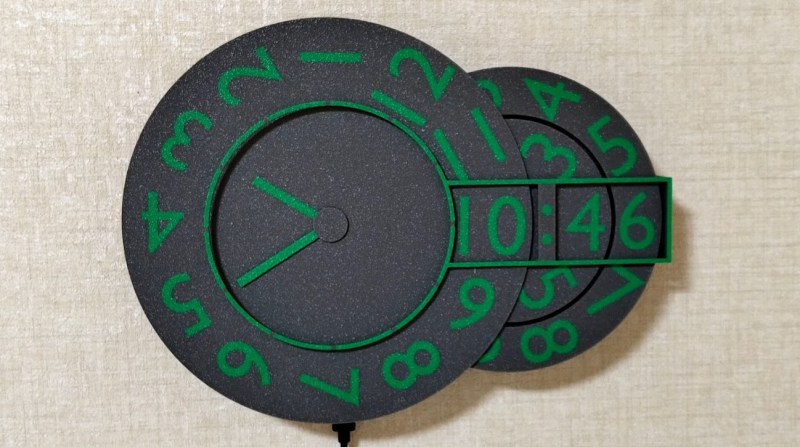After seeing some of the interesting clock builds we’ve featured recently, [shiura] decided to throw their hat in the ring and sent us word about their incredible 3D printed hybrid clock that combines analog and digital styles.
While the multiple rotating rings might look complex from the front, the ingenious design behind the mechanism is powered by a single stepper motor. Its operation is well explained in the video below, but the short version is that each ring has a hook that pushes its neighboring ring over to the next digit once it has completed a full rotation. So the rightmost ring rotates freely through 0 to 9, then flips the 10-minute ring to the next number before starting its journey again. This does mean that the minute hand on the analog display makes a leap forward every 10 minutes rather than move smoothly, but we think its a reasonable compromise.
 Beyond the 28BYJ-48 geared stepper motor and its driver board, the only other electronics in the build is a Seeed Studio XIAO ESP32C6 microcontroller. The WiFi-enabled MCU is able to pull the current time down from the Internet, but keep it mind it takes quite awhile for the mechanism to move all the wheels; you can see the process happen at 60x speed in the video.
Beyond the 28BYJ-48 geared stepper motor and its driver board, the only other electronics in the build is a Seeed Studio XIAO ESP32C6 microcontroller. The WiFi-enabled MCU is able to pull the current time down from the Internet, but keep it mind it takes quite awhile for the mechanism to move all the wheels; you can see the process happen at 60x speed in the video.
If you’re looking to recreate this beauty, the trickiest part of this whole build might be the 3D print itself, as the design appears to make considerable use of multi-material printing. While it’s not impossible to build the clock with a traditional printer, you’ll have to accept losing some surface detail on the face and performing some well-timed filament swaps.
[shirua] tells us they were inspired to send their timepiece in after seeing the post about the sliding clock that just went out earlier in the week.
















The idea is amazing! Sad it is not FOSS.
The link is Instructables if you wanted to build one.
Heh, why is it sad that a hardware project isn’t free or open source software?
Ahaha, right, my bad. Thanks.
It is not OSHW or FOSH.
Does it bother anyone else that the digits say 10:46 but the hands say 10:40?
K thx bai
Oh. The article explains that it is a known limitation:
“Limitation: The minute hand moves once every 10 minutes. In other words, the time resolution of the analog clock is 10 minutes.”
You are right, actually one of my relative said it is uncomfortable.
Using the other program, it can be changed to “analog-priority-mode” without hardware modification. However in this case, the digital display is cluttered :(
please take a look at Step 6 at
https://www.instructables.com/Hybrid-Clock-Mechanical-Fusion-of-Digital-and-Anal/
It’s understandable. What is the software license?
I release all models and softwares under the license of CC BY-NC-SA.
There’s a simple fix: leave enough slop in the mechanism so the minute hand can wiggle around the 10 minute interval and put a catch on the number wheel with a spring and a ball, or magnets, or just friction drag, so it holds the number.
The minute hand then moves forwards 10 minutes past the time to advance the number wheel, then returns back to show the correct time on the dial indicator.
The tradeoff is between mechanical complexity and readability. Given that you only have to build it once, but read it all the time after, I’d consider making it more complex in order to be more readable. Basically, make the analog clock more independent of the digital one.
I like it and feel inspired, though I really don’t like the “wind back” to avoid the interlock pin. I feel like some sort of Geneva mechanism could be used instead.
Guess there’s only one way to find out!
I had designed incremental digital clock using Geneva Drives,
https://www.instructables.com/Geneva-Digital-Clock/
though it has not auto time adjustment since it is incremental.
Yes. That sounds right, analog clock drives digital clock via Geneva mechanism, once a minute.
Not sure how you would set the time…
At work there’s this “atomic” analog-looking clock, which also has a manual set button. Pushing the set button just results in the minute hand moving along faster at a few minutes per second. It’s annoying to set it manually if you need to advance a few hours. But presumably, if it could receive the time signal, the clock would just advance like that by itself until the proper time is reached.
You connect the number wheel to the geneva mechanism with a friction clutch that slides when you turn the number wheel by hand.